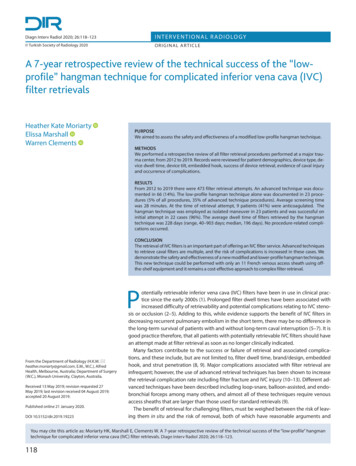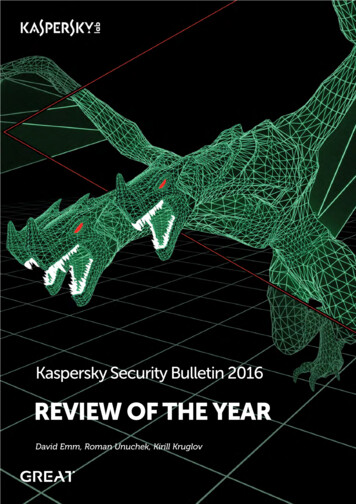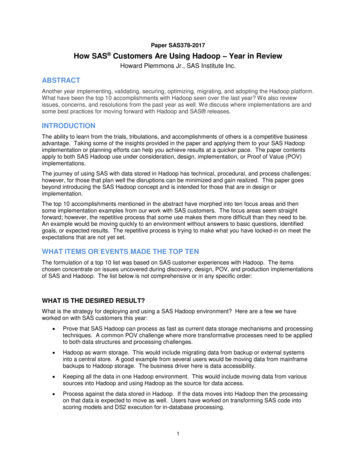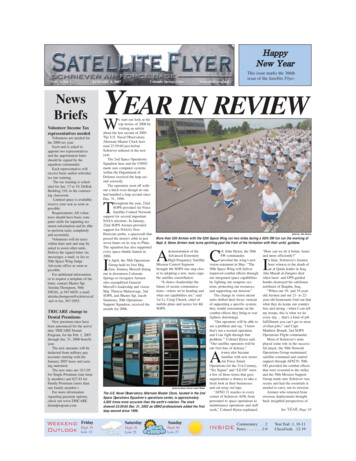
Transcription
Diagn Interv Radiol 2020; 26:118–123I N T E R V E N T I O N A L R A D I O LO G Y Turkish Society of Radiology 2020ORIGINAL ARTICLEA 7-year retrospective review of the technical success of the “lowprofile” hangman technique for complicated inferior vena cava (IVC)filter retrievalsHeather Kate MoriartyElissa MarshallWarren ClementsPURPOSEWe aimed to assess the safety and effectiveness of a modified low-profile hangman technique.METHODSWe performed a retrospective review of all filter retrieval procedures performed at a major trauma center, from 2012 to 2019. Records were reviewed for patient demographics, device type, device dwell time, device tilt, embedded hook, success of device retrieval, evidence of caval injuryand occurrence of complications.RESULTSFrom 2012 to 2019 there were 473 filter retrieval attempts. An advanced technique was documented in 66 (14%). The low-profile hangman technique alone was documented in 23 procedures (5% of all procedures, 35% of advanced technique procedures). Average screening timewas 28 minutes. At the time of retrieval attempt, 9 patients (41%) were anticoagulated. Thehangman technique was employed as isolated maneuver in 23 patients and was successful oninitial attempt in 22 cases (96%). The average dwell time of filters retrieved by the hangmantechnique was 228 days (range, 40–903 days; median, 196 days). No procedure-related complications occurred.CONCLUSIONThe retrieval of IVC filters is an important part of offering an IVC filter service. Advanced techniquesto retrieve caval filters are multiple, and the risk of complications is increased in these cases. Wedemonstrate the safety and effectiveness of a new modified and lower-profile hangman technique.This new technique could be performed with only an 11 French venous access sheath using offthe-shelf equipment and it remains a cost-effective approach to complex filter retrieval.PFrom the Department of Radiology (H.K.M. heather.moriarty@gmail.com, E.M., W.C.), AlfredHealth, Melbourne, Australia; Department of Surgery(W.C.), Monash University, Clayton, Australia.Received 13 May 2019; revision requested 27May 2019; last revision received 04 August 2019;accepted 20 August 2019.Published online 21 January 2020.DOI 10.5152/dir.2019.19223otentially retrievable inferior vena cava (IVC) filters have been in use in clinical practice since the early 2000s (1). Prolonged filter dwell times have been associated withincreased difficulty of retrievability and potential complications relating to IVC stenosis or occlusion (2–5). Adding to this, while evidence supports the benefit of IVC filters indecreasing recurrent pulmonary embolism in the short term, there may be no difference inthe long-term survival of patients with and without long-term caval interruption (5–7). It isgood practice therefore, that all patients with potentially retrievable IVC filters should havean attempt made at filter retrieval as soon as no longer clinically indicated.Many factors contribute to the success or failure of retrieval and associated complications, and these include, but are not limited to, filter dwell time, brand/design, embeddedhook, and strut penetration (8, 9). Major complications associated with filter retrieval areinfrequent; however, the use of advanced retrieval techniques has been shown to increasethe retrieval complication rate including filter fracture and IVC injury (10–13). Different advanced techniques have been described including loop-snare, balloon-assisted, and endobronchial forceps among many others, and almost all of these techniques require venousaccess sheaths that are larger than those used for standard retrievals (9).The benefit of retrieval for challenging filters, must be weighed between the risk of leaving them in situ and the risk of removal, both of which have reasonable arguments andYou may cite this article as: Moriarty HK, Marshall E, Clements W. A 7-year retrospective review of the technical success of the “low-profile” hangmantechnique for complicated inferior vena cava (IVC) filter retrievals. Diagn Interv Radiol 2020; 26:118–123.118
many cases will be patient dependent (2).Despite the associated complication rates,advanced retrieval techniques may be preferable to the risks associated with leavinga filter in place permanently, especiallyin younger patients or those who desirepregnancy (1). Interventional radiologistsneed therefore to be prepared to performboth standard and advanced, complex filterretrievals if offering an IVC filter service. In2015, Al-Hakim et al. (14) described a novelconcept which uses a modified loop-snaretechnique to retrieve filters with an embedded hook. Since around that time, we haveadopted this technique but modified to usethe standard Cook Gunther-tulip retrievalkit, which is of smaller caliber and availableon the shelf in many interventional radiology practices. We describe the feasibility,safety, and success rate of consecutive complicated IVC filter retrievals, where we haveused the modified hangman technique asan isolated retrieval maneuver (15).MethodsEthical approval was granted by the local institutional ethics committee (81/19,29/01/2019) who waived the need for informed consent. We performed a retrospective review of all filter retrieval proceduresperformed at a tertiary referral center andmajor trauma center, from 2012 to 2019. Patients were identified using the hospital picture archiving and communication system(PACS) system. Imaging studies and radiology reports were reviewed for patients undergoing IVC filter removal using the hangman technique at our institution. Recordswere reviewed for patient demographics,device type, device dwell time, device tilt,embedded hook, success of device retrieval, evidence of caval injury, and occurrenceMain points This low-profile hangman technique uses amodified version of the traditional hangmanprocedure and allows use of a standard 11 FCook filter retrieval sheath, negating the necessity of sheath upsizing and ensuing cost.The hangman technique was employed asisolated maneuver in 23 patients and wassuccessful on initial attempt in 22 cases(96%). One procedure required repeat attempt under general anesthetic due to painand was successful on this attempt.No procedure-related complications occurred, including IVC injury or access sitecomplications.of complications. Final inclusion criteriaincluded all consecutive filter retrieval procedures where the hangman technique wasused in isolation, subsequent to failing thestandard basic retrieval technique. All filter types were included. Exclusion criteriaincluded those procedures where an advanced technique was not used and thoseprocedures where more than one advancedtechnique was used during the same procedure (Fig. 1).Filter removal techniqueThe specifics of the hangman techniqueused to remove IVC filters is described byClements et al. (15), and was performed asfollows: Intravenous conscious sedationwith midazolam and fentanyl was utilized inthe majority of cases (n 16); however, somewere performed under general anesthesia(n 6) at the discretion of the operator (forexample, failed basic retrieval with long procedure time or pain at initial retrieval and are-booking made for advanced techniqueunder general anesthetic). All filter removalprocedures were performed by using a rightinternal jugular vein approach. The CookGunther-Tulip IVC filter retrieval kit wasused for all cases, which consisted of a telescoping 11 French (F) 80 cm sheath system(Cook Medical), which was advanced over afixed core 0.035-inch J-wire (Cook Medical)until the sheath tip was situated caudal tothe filter. An initial digital subtraction angiographic (DSA) cavogram was performedthrough the Cook retrieval sheath, prior toattempted removal of all filters to identifyanterior-posterior tilt, penetration of hookand/or legs, relationship to the renal veins,and best working angle to identify the embedded hook (Fig. 2). A 5 F Sos Omni catheter (Angiodynamics) was formed around theneck of the IVC filter (Fig. 3). A 260 cm 0.018inch straight-tipped fixed-core wire (TSF018-260, Cook Medical) was passed throughthe Sos Omni catheter around the neck ofthe filter (care was taken not to engage thefilter struts) to form a loop, with tip of thewire positioned in the juxta/suprarenal IVC.The Sos Omni catheter was then removedand the snare provided in the Cook filterretrieval kit was used to snare the wire (Fig.4). The snare and wire were then pulled backthrough the sheath and removed so that thewire was now looped around the neck of thefilter (Fig. 5a), and both the front and backends of the wire were outside the sheath.Gentle traction was applied to both ends ofthe wire simultaneously, usually with an artery forceps to grip the wire as it exited thesheath. This allowed straightening of the filter and the retrieval sheath to be advancedin short repetitive movements to separatethe hook from the wall.473 consecutive filter retrieval proceduresExcluded standard retrieval proceedures(n 407)66 filter retrieval procedures whereadvanced techniques were documentedExcluded procedures where any advancedtechnique other than the low profilehangman technique alone was utilized(n 43)23 filter retrieval procedures utilizing thelow-profile hangman technique aloneFigure 1. Inclusion and exclusion flow chart.Low-profile hangman technique for complicated IVC filter retrieval 119
Figure 4. The snare and snared end of the 0.018inch wire were pulled back through the sheathand removed. The 0.018-inch fixed core wire isnow looped around the neck of the filter.statistics of the data are presented with n (%).Variables with non-normal distribution areshown as median (min–max or 25–75 percentiles). Variables with normal distributionare shown as mean ( standard deviation).Figure 2. Initial digital subtraction angiographic(DSA) cavogram was performed through theCook retrieval sheath, prior to attemptedremoval of a filter. Filter tilt and an embeddedhook is identified in this case on DSA.Figure 3. A 0.018-inch fixed core wire (CookMedical) is directed around the neck of the IVCfilter, taking care not to engage the filter struts,and the end is snared using the snare providedin the Cook filter retrieval kit (Cook Medical).With forward pressure on the sheathand very gentle counter traction on the0.018-inch wire ends, the sheath was thenadvanced over the hook and filter in thestandard manner (Fig. 5b). The wire wasable to either engage the hook directly orvia adherence to the covering fibrosis inalmost all cases. On one occasion, the wirewas only able to free the hook from thewall, and in this case the standard snare inthe Gunther-Tulip kit was used to snare thefreed hook in a standard manner and thefilter was removed (Fig. 5b). After filter re-moval, digital subtraction cavography wasperformed in all cases, through the outersheath (Fig. 6). The explanted filter was inspected for fracture or defect. Patients wereobserved for a minimum of 2 hours afterthe procedure and all were discharged onthe same day per our department protocol.Statistical analysisResults were pooled and analyzed. Variables were assessed for normality via the chisquare test using Real Statistics add-on forMicrosoft Excel (Microsoft Corp.). Descriptive120 March–April 2020 Diagnostic and Interventional RadiologyResultsFrom 2012 to 2019 there were 473 filterretrieval attempts (Table 1). An advancedtechnique was documented in 66 (14%)of these cases. Of these cases, use of thehangman technique alone was documented in 23 procedures (4.9% of all procedures,34.8% of advanced technique procedures),whilst the remaining 43 cases either used adifferent technique or more than one technique simultaneously.There were 13 males (59.1%) with meanage of 47.68 3.90 years (range, 26–86years). Most filters retrieved were Cook Celect Platinum (Cook Medical) (n 19, 82.6%),while two filters (8.7%) were optional ALNvena cava filter (ALN implants chirurgicaux,Ghisonaccia) and one filter (4.3%) was CookCelect (Cook Medical). The median tilt wasMoriarty et al.
Figure 5. With forward pressure on the sheath and gentle retraction on the 0.018-inch fixed core wireends, the sheath is then advanced over the hook and filter in the standard manner.Table 1. Overall procedure successVariableValueNumber of IVC filter retrievals473Number of advanced techniques, n (%)66 (13.95)Number of isolated low-profile hangman techniques, n (% of total)23 (4.86)Successful at initial attempt, n (%)22 (95.96)Successful overall, n (%)23 (100)Complication, n (%)0 (0)Table 2. Statistical variablesVariableValueAge (years), mean SD47.7 3.9Male gender, n (%)13 (59.1)Screening time (min), mean SDDwell time (days), median (range)27.72 5.75196 (40–903)Tilt (degrees), median (range)11.5 (2–19)Anticoagulation during retrieval, n (%)19 (82.60)Cook Celect Platinum filter, n (%)9 (40.91)Figure 6. Digital subtraction cavography isperformed post filter removal, through the outersheath.11.5 (range, 2 –19 ). The mean screeningtime was 27.72 5.75 minutes. At the timeof retrieval attempt, 9 patients (40.9%) weretaking therapeutic anticoagulation (lowmolecular weight heparin, novel anticoagulant, or warfarin) while the others had eitherceased or were not taking anticoagulation(variables are shown in Table 2).This technique was employed as an isolated maneuver in 23 patients (4.9%) andwas successful on initial attempt in 22 cases(95.6%). In one case after the hangman wirewas successfully placed around the filterneck, the patient experienced abdominalpain whilst the sheath was being advancedover the hook. In spite of intravenous sedation and analgesia, a decision was made toabandon, and a second attempt with general anesthesia was performed which wassuccessful on that attempt. The mediandwell time of filters retrieved by the hangman technique was 196 days (range, 40–903days). No filter migration or fractures, eitherprior to or during the retrieval proceduresoccurred. Postprocedure cavography wasperformed in all patients. No procedure-re-Low-profile hangman technique for complicated IVC filter retrieval 121
lated complications occurred, including IVCinjury or access site complications.DiscussionNeointimal hyperplasia of the filter hookin tilted filters, i.e., “embedded hook”, continues to be a significant reason for failureof retrieval (16). A wide variety of advancedtechniques are described, which can beused to retrieve caval filters when the standard retrieval technique fails. These includethe use of angioplasty balloons, additionalsnares, guidewires, endobronchial forcepsand endovascular laser. These techniqueshave various technical success rates andcomplication rates, some of which is likelyto be in part related to operator preference,experience, and prior success (11, 17–22).The use of a loop snare was describedby Rubenstein et al. (21), who used thisapproach successfully to retrieve eight tilted IVC filters. This technique involved theuse of a 16 F sheath, formation of a reversecurve catheter below the filter, extending a Bentson wire (0.035 inches, 260 cm;Cook Medical) above the hook which issubsequently snared with a snare device.The 16 F sheath is then advanced over thefilter, and the filter is pulled back into thesheath and retrieved (21). Slight variationshave subsequently been described, including variation in the reverse curve catheter,wires and additional equipment such as aLiver Access and Biopsy Needle Set. Varioussuccess rates have been described rangingas 70%–100% (16, 22). Lynch et al. (22) consider that particular filter types included inthe study (Bard Recovery, G2, G2 Express,and Eclipse Inferior Vena Cava Filters) maylend themselves favorably to the techniqueas they are made of thin wire Nitinol, whichis pliable enough to fold over into a sheath.In 2012, Esparaz et al. (23) described thetechnique of forming a reverse curve catheter and wire around the radiolucent fibrinat the filter apex of a Celect filter, and subsequent removal with a standard snare device.In 2015, Al-Hakim et al. (14) further slightlymodified this procedure. The hangmantechnique is based on the loop snare technique; however, the reverse curve catheterand wire loop is formed between the filterneck and IVC wall, as opposed to betweenthe filter struts or the fibrin cap. The filterwas then retrieved using the in situ wireloop snare, or if the wire loop slipped off thefilter hook, through the fibrin cap, and thefilter hook was subsequently snared. Thesuccess rate was 81.8% (9 of 11 cases) in thisseries, and no complications were encountered (14). Of note, this technique has beendescribed as requiring a 14 F sheath, whichnecessitates a larger than normal venotomyas well as a specific sheath to be acquiredseparate to a standard retrieval set. Whilethis may not be of concern to some operators, in patients where therapeutic anticoagulation is continued during retrieval itmay be less desirable.Doshi et al. (24) described a 90% success rate with the hangman technique in29 cases used on 7 different filter types.No procedure related complications wereencountered; however, the specifics of thetechnique were not published (24).The new hangman technique preferredat our institution, and described recently by Clements et al. (15) in a case report,uses a modified version of the traditionalhangman procedure (16) and allows useof a standard 11 F Cook Gunther-Tulip retrieval sheath and 0.018-inch 260 cm fixedcore wire (Cook Medical) to be used, ratherthan exchanging for a larger sheath with an0.035-inch wire. The middle sheath (of thetelescoping 3-sheath system in the retrievalkit) is firm, which negates the need for extra stabilizing equipment such as the liveraccess and biopsy needle set (Cook Medical). Our low-profile technique retrieves thefilter without folding the filter, as describedby Lynch et al. (22). Although no filter fractures due to retrieval were described byLynch et al. (22), the low-profile hangmantechnique allows the filter to be retrievedin a manner similar to manufacturers recommendations, which we consider woulddecrease the risk of filter fracture, whencompared to techniques where the filter isfolded in situ prior to retrieval.In spite of the low-profile nature of thismethod, we achieved 100% technical success, with only one procedure requiring repeat attempt under general anesthetic dueto pain. There were no complications andthis is encouraging especially given that40.9% of the cohort remained on therapeutic anticoagulation during the procedureand this supports prior literature (25).Literature on the hangman technique isscarce. Previously described 81%–90% technical success rates using the hangman technique are comparable to our retrieval rate of100%. We advocate the use of an 0.018-inchfixed-core wire, which allows smaller sheathsize and use of the standard Cook retrieval122 March–April 2020 Diagnostic and Interventional Radiologykit, with the only additional necessary equipment being a 260 cm fixed core wire and reverse curve catheter such as the Sos Omni. Inour institution this adds only 42 USD extra tothe retrieval set cost, which may make this acost-effective option compared to purchasing and sterilizing endobronchial forceps.In addition, these items are more likely tobe found on the shelf of a standard interventional radiology practice without priorarrangements needing to be made for special stock. This means that managing an unexpectedly difficult retrieval may not need arepeat procedure with stock being ordered,but simply continuing to use the standardaccess set and combining a low-cost set ofitems most likely on the shelf. There may befurther such advantages in workflow and reducing repeat bookings, which is especiallyhelpful if anticoagulation was ceased specifically for the procedure.It must be acknowledged that cases selected to be suitable for this technique weremade at operator discretion and thus introduces significant selection bias. In addition,while
The Cook Gunther-Tulip IVC filter retrieval kit was used for all cases, which consisted of a tele-scoping 11 French (F) 80 cm sheath system (Cook Medical), which was advanced over a fixed core 0.035-inch J-wire (Cook











